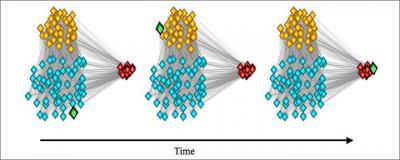Objective Testing of Individual Learning Capacity
Researchers collected brain imaging data from people performing a motor task, and then analysed this data using new computational techniques. They found evidence that the 'flexibility' of a person's brain - how much different areas of the brain link up in different combinations; essentially 'swapping partners' - can be used to predict how fast someone will learn. _PO
Scientists are developing better tools for testing human cognitive capacity objectively. In a recent study featuring an international scientific team from Oxford University, UC Santa Barbara, and UNC Chapel Hill, sophisticated brain imaging techniques were used to predict how quickly individuals could learn particular motor tasks.
The new study uses computational methods developed to analyze what the researchers call multilayer networks, in which each layer might represent a network at one snapshot in time, or a different set of connections between the same set of brain regions. These layers are combined into a larger mathematical object, which can contain a potentially huge amount of data and is difficult to analyze. Previous methods could only deal with each layer separately.
..."Parts of the brain communicate with one another very strongly, so they form a sort of module of intercommunicating regions of the brain," said first author Danielle S. Bassett, postdoctoral fellow in physics at UC Santa Barbara. "In this way, brain activity can segregate into multiple functional modules. What we wanted to measure is how fluid those modules are."
Bassett explained that there are flexible brain regions with allegiances that change through time. "That flexibility seems to be the factor that predicts learning," said Bassett. "So, if you are very flexible, then you will end up learning better on the second day, and if you are not very flexible, then you learn less." _PO
The ability to objectively measure cognitive capacity using brain imaging, bypasses most of the problems identified with IQ testing. During a brain imaging session, the person does not necessarily know what is being measured, and could not likely influence the measured outcome even if he tried -- short of withholding cooperation entirely. And that would be quite obvious to observers.
With the ability to objectively measure cognitive capacity, we are faced with a "put up or shut up" moment. If scientists seriously want to accurately measure group differences in IQ and cognitive ability, they now have the tools to do so. But if they only want to shout down opposing viewpoints without doing the work to get to the heart of the matter -- they will continue to shout, grouse, whine, and grumble. Which is it to be?
Labels: cognition, learning research


2 Comments:
***The ability to objectively measure cognitive capacity using brain imaging, bypasses most of the problems identified with IQ testing.***
This was what Arthur Jensen was hoping to do with chronometric measures.
Right. Similar chronometric assessments can be made using sophisticated brain imaging.
The difference is that the actual brain activity can be localised across the cooperating centers and networks as it happens, then correlated with whatever behaviours are being used to trigger the brain activity.
Higher order chronometrics.
Post a Comment
“During times of universal deceit, telling the truth becomes a revolutionary act” _George Orwell
<< Home